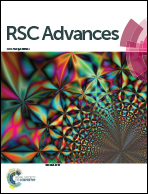Novel highly conductive ferroferric oxide/porous carbon nanofiber composites prepared by electrospinning as anode materials for high performance Li-ion batteries†
Abstract
In this paper, ferroferric oxide (Fe3O4) nanoparticles/porous carbon nanofiber (Fe3O4/PCNFs) composites were successfully fabricated by electrospinning and subsequent calcination. The composites were characterized by X-ray diffraction, thermogravimetric analysis, scanning electron microscopy and transmission electron microscopy to analyze the structure, composition and morphology. The electrochemical performance was evaluated by coin-type cells vs. metallic lithium. The results indicated that Fe3O4/PCNFs composites exhibited high reversible capacity and good capacity retention. The discharge capacity was maintained at 717.2 mA h g−1 at 0.5 A g−1 after 100 cycles. The excellent performances of Fe3O4/PCNFs composites are attributed to good crystallinity and uniformly dispersive Fe3O4 nanoparticles, and a porous carbon shell with high conductivity. The carbon coating buffered the tremendous volumetric changes between Fe3O4 nanoparticles and Fe atoms in the charge/discharge processes and kept the structure integrity of Fe3O4 nanoparticles. Porous carbon nanofibers prepared by the unique calcination process improved the conductivity of composites and provided free space for migration of lithium ions. The preparation strategy is expected to be applicable to the preparation of other transition metal oxide materials as superior anode materials for lithium-ion batteries.


 Please wait while we load your content...
Please wait while we load your content...